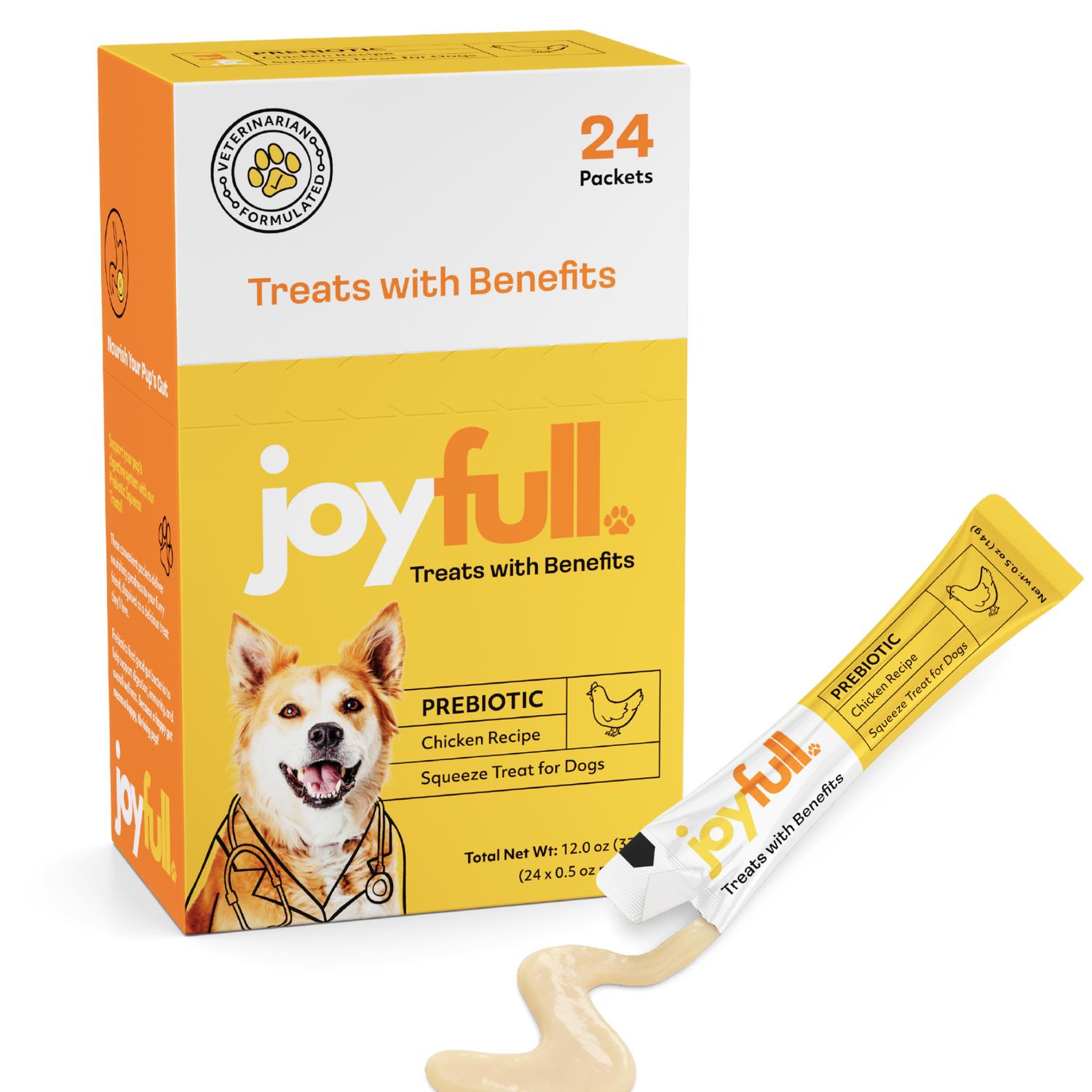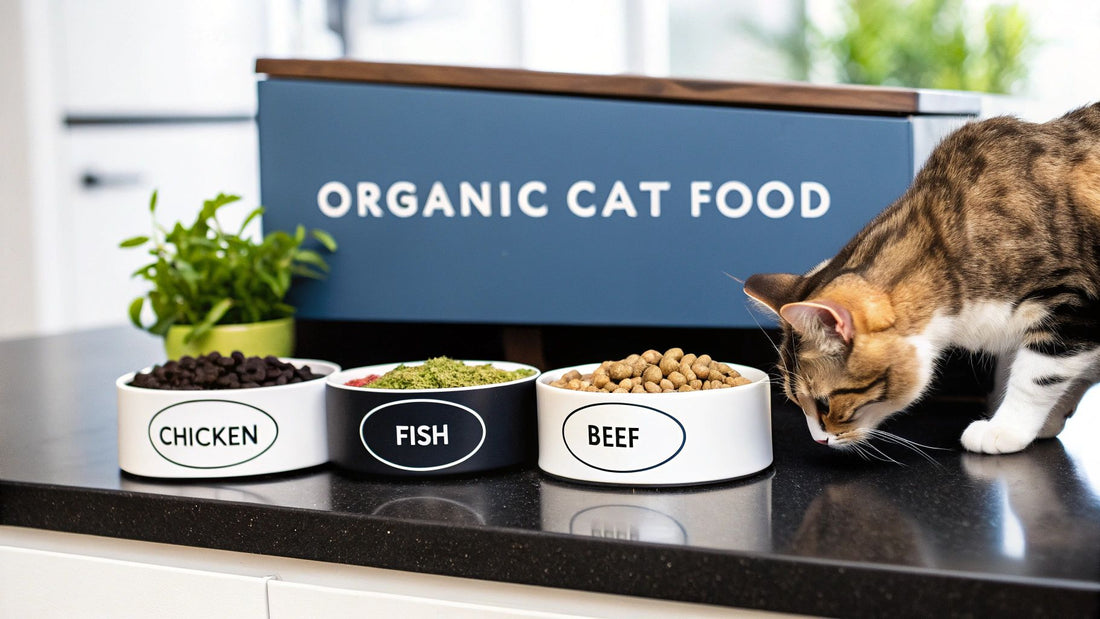
Finding the Best Organic Cat Food for Your Pet
When you're trying to find the best organic cat food, you'll quickly realize it's less about a single "best" brand and more about finding one that meets a specific set of high standards. The real winners focus on certified organic ingredients, a complete nutritional profile for your cat’s specific life stage, and total transparency about where their ingredients come from. This guide will help you sort through the noise and find the right food for your cat.
Why Choose Organic Cat Food

Switching to organic cat food isn't just a trend; it's a serious investment in your pet’s long-term health. The whole idea is pretty simple: cleaner ingredients make for a healthier cat. So many conventional pet foods are packed with cheap fillers and artificial junk, but certified organic options have to follow strict rules for production.
This commitment to quality means the food is made without synthetic pesticides, hormones, antibiotics, or genetically modified organisms (GMOs). For our cats—who are obligate carnivores and need meat to thrive—the quality of that protein source is everything. Organic recipes guarantee that the meat comes from animals raised in specific, humane, and natural conditions.
The True Benefits for Feline Health
Going organic is about more than just dodging unwanted chemicals. It’s about giving your cat superior nutrition that supports their entire body, and the benefits often show up in ways you can actually see.
- Improved Digestion: Organic foods usually skip common allergens and fillers like corn and soy that can upset a cat's stomach. This leads to better nutrient absorption and way fewer digestive problems.
- Healthier Skin and Coat: When a cat's diet is full of high-quality proteins and fats, without artificial additives, you'll often notice a shinier, softer coat and less flaky, irritated skin.
- Enhanced Energy Levels: Nutrient-dense food provides clean, efficient fuel. This helps your cat stay active and maintain a healthy weight without the crashes that come from cheap carbs.
- Stronger Immune System: By cutting out the chemical load from pesticides and synthetic preservatives, you’re taking a lot of stress off your cat’s immune system, allowing it to function at its best.
Understanding the Difference
It’s so important to know what sets "certified organic" apart from fuzzy marketing terms like "natural" or "holistic." Seeing that USDA Organic seal on the bag is a guarantee. It means the product has met strict federal guidelines and that at least 95% of its ingredients are organic. This certification gives you the confidence that you’re actually getting the quality you're paying for.
The real value of organic cat food is that it's proactive. You're not just feeding your cat for today; you're minimizing their exposure to potentially harmful stuff to support their health for years to come.
This guide will break down how to read labels properly and compare the top brands out there. A great first step is learning what to watch out for. You can get a head start by checking our detailed list of cat food ingredients to avoid to help you make smarter choices.
Decoding Organic Cat Food Labels
Walking down the cat food aisle can feel overwhelming. You're bombarded with terms like "organic," "natural," and "holistic," all fighting for your attention. To find the best food for your cat, you have to cut through the noise and understand what these labels actually mean.
Unlike some of the other buzzwords, "organic" isn't just clever marketing—it's a legally defined and regulated standard. When you see that official USDA Organic seal on a bag of cat food, it's a real promise of quality.
That seal is your guarantee that the product is made with at least 95% certified organic ingredients. The certification process is no joke; it means every single step, from the farm where the ingredients were grown to the final product in the bag, meets strict federal rules.
What Does Organic Certification Really Mean?
When you choose a certified organic food, you're not just getting high-quality ingredients; you're also avoiding a whole list of things you probably don't want in your cat's bowl. The entire system is built on a cleaner, more sustainable way of producing food.
Specifically, certified organic cat food is guaranteed to be made without:
- Synthetic Pesticides and Herbicides: The plants and grains in the food are grown without these chemicals, which means less risk of your cat ingesting potentially harmful residues.
- Genetically Modified Organisms (GMOs): Every ingredient has to be non-GMO. This applies to the veggies, the grains, and even the feed given to the animals used for meat.
- Antibiotics or Growth Hormones: The chicken, beef, or turkey in the food comes from animals raised without being routinely pumped full of antibiotics or artificial growth promoters.
- Artificial Preservatives, Colors, or Flavors: The recipe must be clean and simple, without any synthetic additives that provide zero nutritional value and can sometimes cause allergic reactions or sensitivities.
For many of us, this commitment to clean ingredients is the biggest reason to seek out organic options. It just gives you peace of mind.
Organic vs. Natural vs. Holistic
This is where things get tricky, and where a lot of well-meaning cat owners get confused. The words "natural" and "holistic" sound wonderful, but they don't have the same legal or regulatory backing as "certified organic." Knowing the difference is crucial.
Key Takeaway: "Natural" usually just means the food doesn't have artificial additives, but the term isn't policed by the USDA like "organic" is. "Holistic" has no legal definition whatsoever—it’s purely a marketing term that a brand can use however it wants.
Let's put these common labels head-to-head to clear things up.
| Label Term | Definition & Regulation | What It Means for Your Cat |
|---|---|---|
| Certified Organic | Legally defined by the USDA. Requires 95%+ organic ingredients grown without synthetic pesticides, GMOs, or hormones. | A verifiable guarantee of ingredient quality and farming methods. This is the highest standard you can find. |
| Natural | Loosely defined by AAFCO. Usually means it's free of artificial colors, flavors, and preservatives. It says nothing about how the ingredients were farmed. | It's a decent start, but it doesn't ensure ingredients are free from pesticides or GMOs. |
| Holistic | No legal or official definition. It's a marketing term, plain and simple. | The meaning is entirely up to the brand and offers zero guarantees about quality, ingredients, or production. |
By looking for the USDA Organic seal, you can confidently sidestep the marketing fluff and know you're getting a product that meets a truly high standard. Having this basic knowledge is the first step in picking a great food. For a more comprehensive look at making smart choices, check out our guide on how to choose the right cat food for more tips. At the end of the day, learning to read the label is the best thing you can do for your cat's nutrition.
How We Sized Up the Best Organic Cat Food
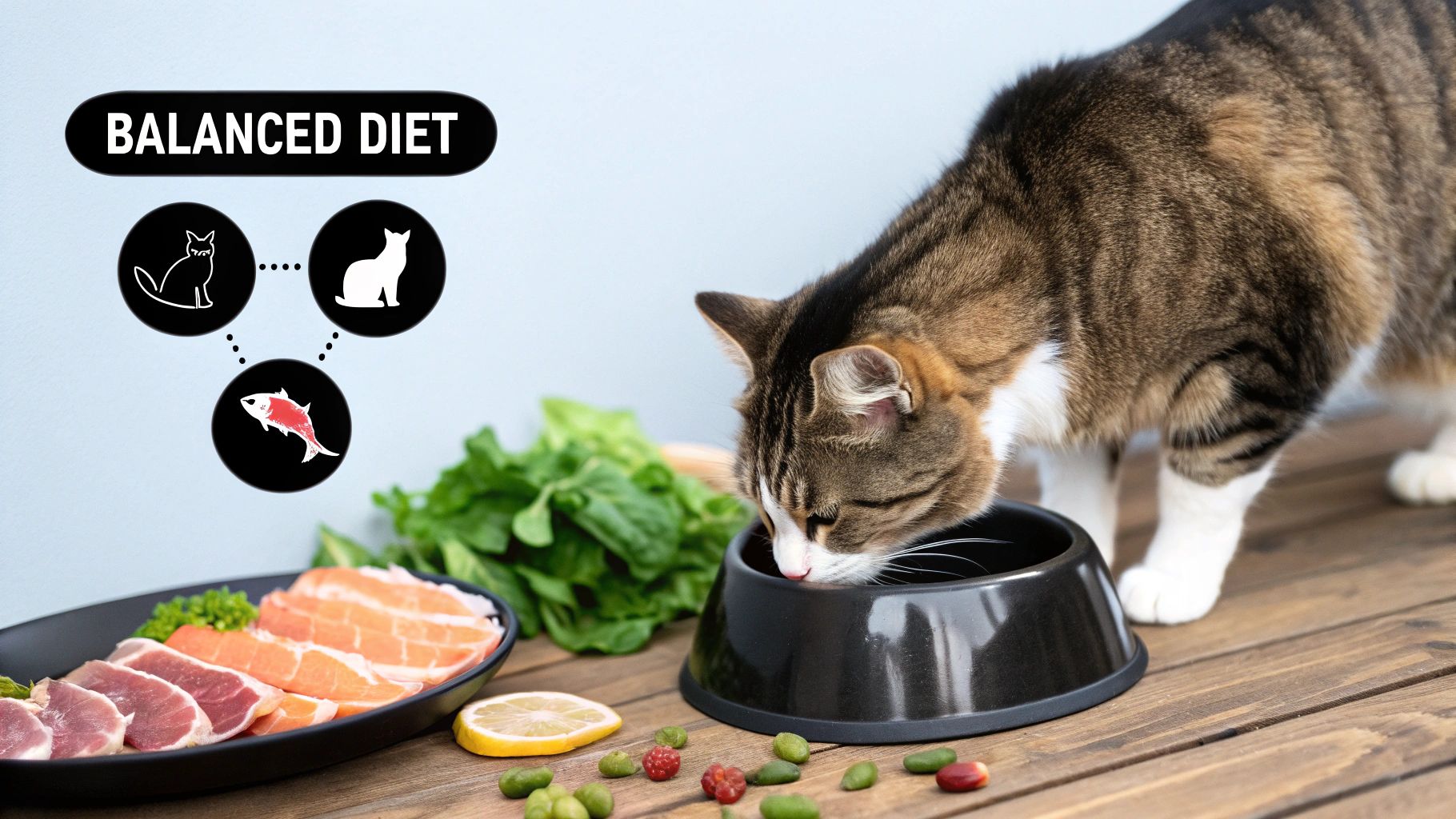
Picking the right organic cat food means looking past the pretty packaging and marketing slogans. To give you recommendations that actually mean something, we developed a clear-cut framework for evaluating what really matters for your cat’s health.
Our aim isn't just to list off features. It's to give you the insight you need to make the best choice for your furry family member. We dug into everything from where a brand sources its chicken to how its formulas are balanced for different life stages. This is how we keep our comparisons fair, honest, and genuinely useful.
Ingredient Quality and Sourcing
The heart of any great cat food is its ingredient list. The first thing we do is scan the first five ingredients, since they make up the majority of what's in the bag. We’re looking for a high-quality, named animal protein—like "organic chicken" or "organic turkey"—right at the top.
But we don't stop there. We also investigate where those ingredients come from. Brands that are open about their sourcing, telling you which farms or regions they partner with, immediately get a nod from us. That kind of traceability is a huge sign that a company is serious about quality control from farm to bowl.
Think about it: organic chicken from a regulated U.S. farm comes with a much higher level of assurance than ingredients from an unknown international supplier with looser rules. This detail is absolutely critical for the purity and safety of the final product.
Nutritional Profile and Life Stage Appropriateness
A nutritionally complete formula is non-negotiable. We confirm that every food we review meets or exceeds the standards set by the Association of American Feed Control Officials (AAFCO) for a specific life stage, whether it's for a kitten, adult, or senior cat.
Beyond just meeting the minimums, we analyze the macronutrient balance. Cats are obligate carnivores, which means their bodies are designed to thrive on a diet high in animal protein and healthy fats, with very few carbs. A grain-free organic option, for example, can be a game-changer for a cat struggling with weight or digestive issues because it cuts out common carb-heavy fillers.
A huge part of our review is making sure a food's nutritional profile is actually practical. We look for formulas that help with common issues like food sensitivities, urinary tract health, or the extra protein a growing kitten needs.
Brand Transparency and Certifications
Words like "premium" and "gourmet" are easy to print on a bag, but third-party certifications are what provide real proof of quality. The single most important stamp of approval we look for is the USDA Organic seal. It’s the only way to be certain that at least 95% of the ingredients are certified organic and free from synthetic pesticides, GMOs, and added hormones.
We also have a lot of respect for brands that go the extra mile with transparency. This includes:
- Making sourcing information public for their key ingredients.
- Sharing details about their manufacturing and quality control processes.
- Being willing to provide third-party lab results for safety and nutrient analysis.
This level of openness builds trust and shows a real commitment to making a safe, high-quality product. This push for transparency is changing the whole pet food industry. The global cat food market is on track to hit USD 49.0 billion by 2034, and organic options are a major reason for that growth. You can see more insights on the cat food market’s expansion on Market.us.
Palatability and Real-World Feedback
At the end of the day, the most nutritious food in the world is useless if your cat turns their nose up at it. To figure out if cats actually like the food, we dive deep into customer reviews and real-world feedback. We search for patterns in comments about the food's texture, smell, and whether notoriously picky eaters will even touch it.
For instance, we consider a food a winner if we see review after review from owners saying their cat licked the bowl clean or that switching from their old food was a breeze. This real-world test is the final piece of the puzzle, ensuring our recommendations aren't just healthy, but officially cat-approved.
Comparing Top Organic Cat Food Brands
Picking the right organic cat food means looking past the pretty packaging. To really find the best option for your cat, you have to dig into what makes each brand different. We're going to skip the marketing fluff and compare the top players based on what truly matters: protein quality, specialized formulas, and the great grain debate.
This isn't about finding a single "best" brand for everyone. It's about finding the perfect fit for your cat's age, health, and unique needs. It's a choice more and more pet owners are making. The organic cat food market was valued at an impressive USD 7.29 billion in 2022 and is expected to hit nearly USD 8.94 billion by 2025. This isn't just a trend; it’s a fundamental shift in how we view pet nutrition.
So, what's the big difference? This chart gives a quick snapshot of how organic foods stack up against conventional ones nutritionally.
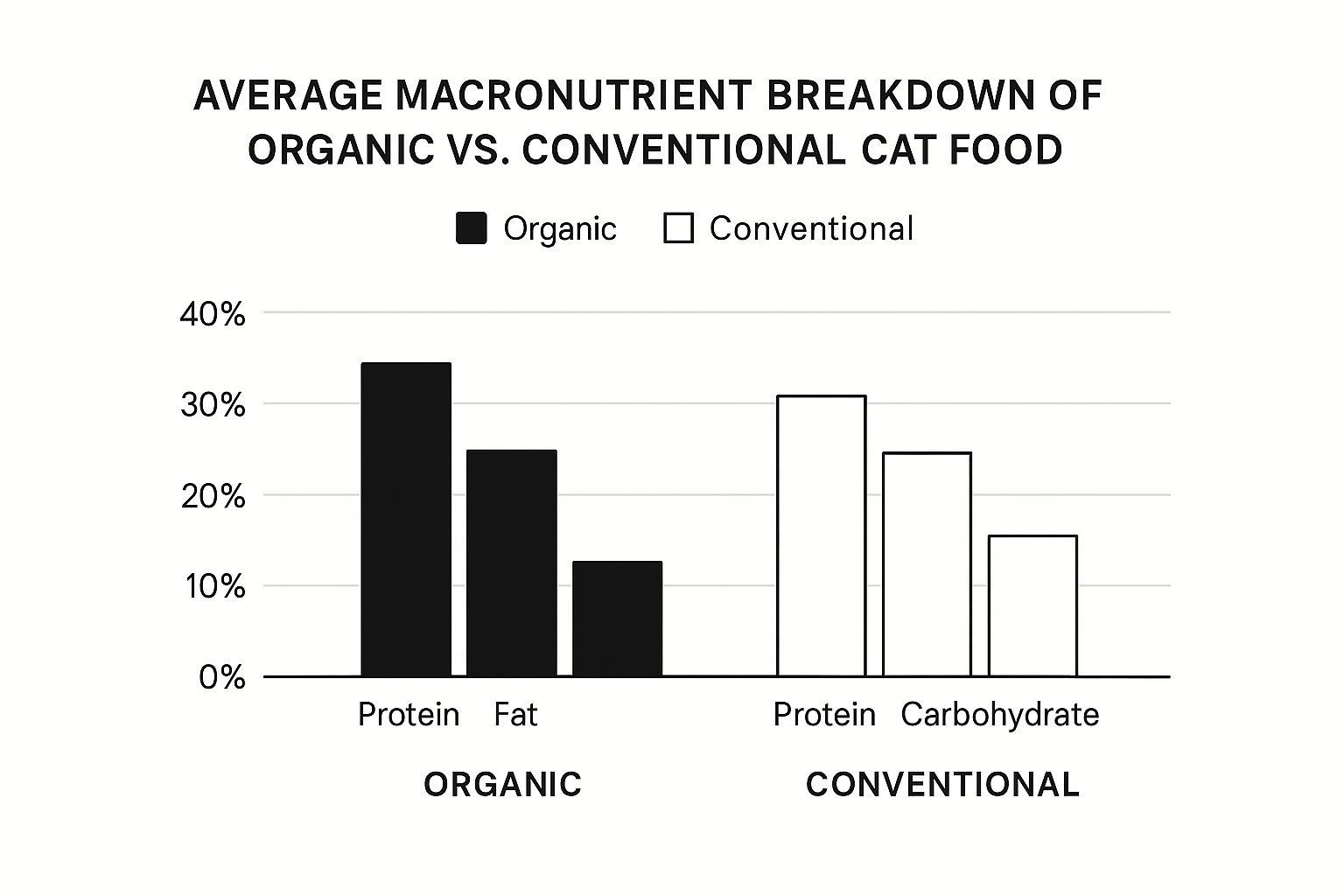
As you can see, organic recipes tend to be higher in protein and fat while keeping carbs low. This mirrors the natural diet of a carnivore much more closely.
A Head-to-Head Look at Protein Sources
The number one ingredient on any cat food label should always be a high-quality animal protein. Period. Cats are obligate carnivores, and this is the non-negotiable foundation of their diet. While top organic brands all start with certified organic protein, their choices create some important distinctions.
For instance, a brand like Joyfull often centers its recipes around a single protein source, like humanely raised, certified organic chicken. This approach is a lifesaver for cats with food sensitivities, as it dramatically simplifies the ingredient list and reduces the chances of a reaction.
Another brand might opt for a multi-protein blend, mixing something like organic chicken with organic salmon. This provides a wider array of amino acids and beneficial omega-3s from the fish, which is fantastic for skin and coat health. But for a cat with a suspected chicken allergy, it's not the right choice.
Key Differentiator: The decision between a single-source or multi-protein formula is completely situational. For a cat with a touchy stomach, the focused, single-protein recipe is usually the safer bet. For a healthy adult cat with no known issues, the diverse nutrient profile of a multi-protein blend can be a great benefit.
A solid protein base is everything. For a deeper dive, our guide to the best high-protein cat food breaks down why it's so vital for your cat's health.
Specialty Formulas: Kittens, Seniors, and Special Needs
A cat isn't just a cat—their needs change drastically from kittenhood to their golden years. A bouncing kitten needs a ton of calories and protein to grow, while a senior cat needs joint support and fewer calories. The best brands get this and craft specific formulas for each life stage.
This is where you can really see the difference in quality.
Kitten Formulas
A premium kitten formula from a brand like Joyfull will be packed with DHA, an omega-3 fatty acid that’s absolutely critical for brain and eye development. They’ll also crank up the protein to around 40% or more to build strong muscles and keep the kibble size tiny for little teeth.
Another brand might meet the basic AAFCO standards for kittens but use a less optimal fat source that lacks high levels of DHA. It’s still a good food, but it doesn't offer that same targeted support for a growing kitten's mind and body.
Senior Formulas
For older cats (usually 7+ years), the nutritional game plan shifts to maintenance and proactive support. A truly thoughtful senior formula should include:
- Controlled Phosphorus Levels: This is crucial for supporting kidney health, a very common issue in older felines.
- Glucosamine and Chondroitin: Often sourced from organic chicken cartilage, these compounds help keep aging joints comfortable and mobile.
- Lower Calorie Count: Helps prevent weight gain as activity levels naturally decrease, but without sacrificing the high-quality protein needed to maintain muscle mass.
Be wary of brands that just slap a "senior" label on their adult food without making these critical adjustments. Always check the ingredient list and guaranteed analysis.
Before we crown a winner, here's a quick comparison to help you see how some of the top brands stack up at a glance.
Organic Cat Food Brand Comparison
This table breaks down the key features of leading brands to help you match their strengths to your cat’s specific needs.
| Brand | Primary Organic Protein | Life Stage Formulas | Key Differentiator | Best For |
|---|---|---|---|---|
| Joyfull | Single-Source (Chicken) | Kitten, Adult, Senior | Humanely raised, certified organic ingredients with a focus on digestive health. | Cats with sensitive stomachs or potential food allergies. |
| Brand B | Multi-Protein (Chicken & Fish) | Adult, All Life Stages | Blended proteins for a diverse amino acid profile and added omega fatty acids. | Healthy adult cats without known sensitivities who could benefit from coat support. |
| Brand C | Single-Source (Turkey) | Adult, Indoor Cat | Grain-free recipes with low-glycemic carbs like sweet potatoes. | Cats with confirmed grain allergies or owners preferring a grain-free diet. |
| Brand D | Multi-Protein (Beef & Lamb) | All Life Stages | Includes healthy, organic whole grains like brown rice for added fiber. | Active cats who digest grains well and need sustained energy. |
Each brand has a clear purpose. The key is aligning that purpose with your cat’s individual profile.
The Great Debate: Grain-Free vs. Grain-Inclusive
The "grain-free" conversation is a big one, and you'll find great organic options on both sides. The right answer for your cat comes down to their individual digestion.
A grain-free organic formula is the go-to for any cat with a known sensitivity to common grains like corn or wheat. These foods use alternative carbs like organic peas or sweet potatoes. For a cat suffering from skin irritation or digestive upset, making this switch can often be a game-changer.
On the flip side, a grain-inclusive organic formula from a quality brand might use healthy whole grains like organic barley or brown rice. For most cats, these are perfectly digestible and offer a great source of fiber. They are not just cheap "fillers" when used correctly.
Situational Recommendation: Don't automatically assume grain-free is better for every cat. If your cat is happy and healthy on a diet with grains, there’s no medical reason to change. But if you suspect a food sensitivity is at play, a high-quality, grain-free organic food is the perfect place to start your investigation.
In the end, comparing these brands is a personal journey. By looking closely at their protein sources, life-stage formulas, and approach to grains, you can find the diet that will help your cat thrive for years to come.
Switching Your Cat to Organic Food: A Step-by-Step Guide
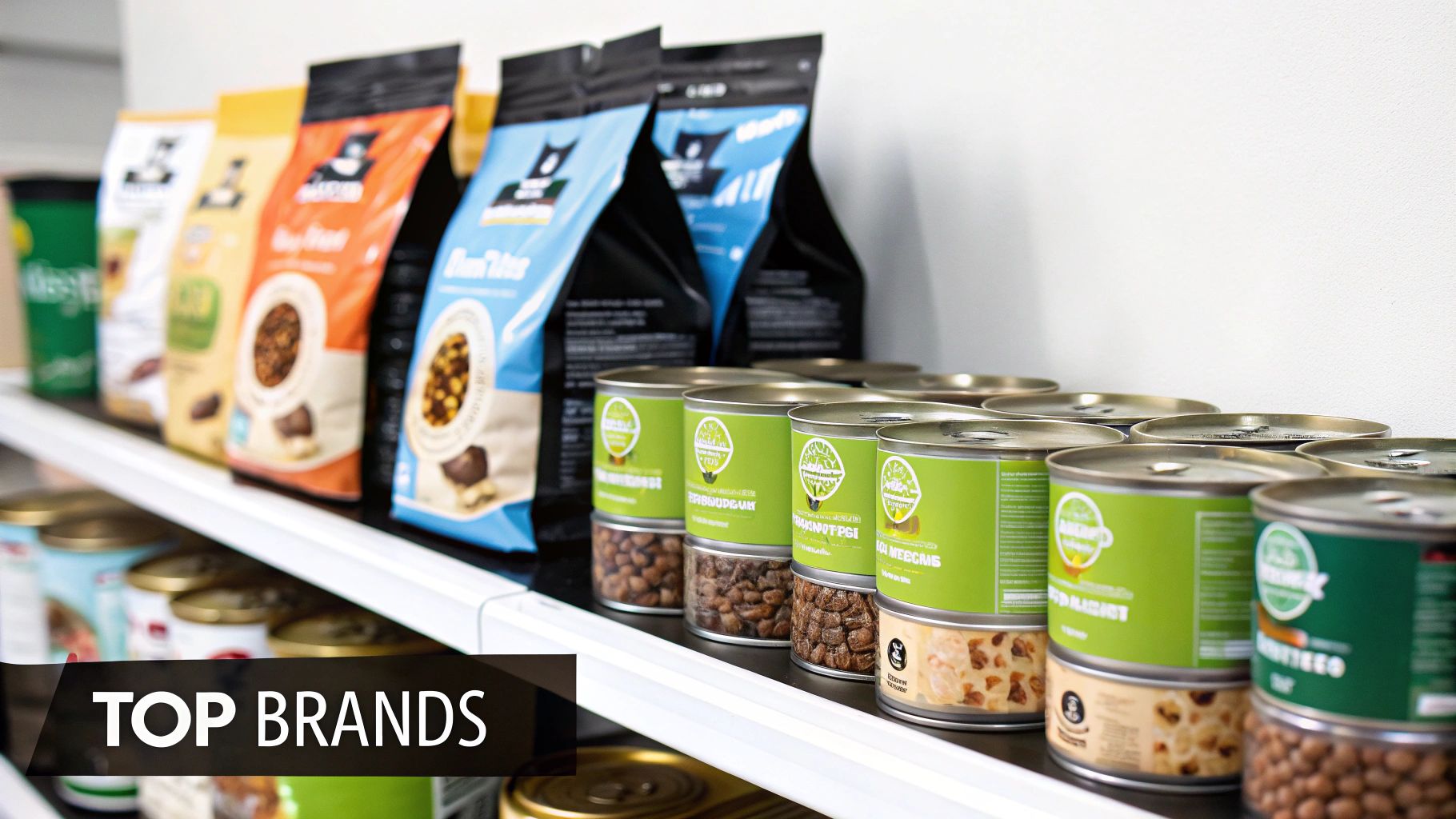
So, you’ve picked out a high-quality organic cat food. The next big step is getting your cat to actually eat it. Cats are notorious creatures of habit, and if you swap their food overnight, you’re likely to face either a hunger strike or some serious digestive issues. The secret to a happy cat and a clean floor is a slow, gradual transition.
The whole point is to give your cat’s digestive system time to catch up. A sudden change in ingredients and nutrient ratios can be a shock to their gut. Rushing the process is probably the number one mistake people make, and they often assume their cat hates the new food when, really, they just needed more time.
The Gradual Transition Plan
Patience is your best friend here. For most cats, a transition period of 7 to 10 days is the sweet spot. This slow introduction helps prevent stomach upset, vomiting, or diarrhea and gives their gut microbiome a chance to adapt to the new, cleaner formula.
Here’s a simple, field-tested schedule that works for almost any cat:
- Days 1-2: Start with a mix of 75% old food and 25% new organic food. Stir it all together so they can't just pick out their old favorites.
- Days 3-4: Shift the balance to a 50/50 mix of the old and new food. This is a good time to keep an eye on the litter box to make sure everything looks normal.
- Days 5-6: Now you can tip the scales to 75% new food and just 25% of the old stuff. By now, your cat should be getting used to the taste and smell of their upgraded meal.
- Day 7 and Beyond: If your cat is happy and their digestion is fine, it’s time to go 100% organic. You did it!
Introducing the food this way makes the change feel natural, not jarring, which dramatically increases the odds of your cat accepting it.
What to Do When Your Cat Says "No"
Even with the best-laid plans, a particularly fussy cat might turn up their nose. If your cat is putting up a fight, don't throw in the towel. There are a few tried-and-true tricks you can use to win them over.
Sometimes, the issue is as simple as texture. If you’re moving from a pâté-style wet food to one with shreds and gravy, that difference can be a dealbreaker for a sensitive cat.
Pro Tip: Is your cat snubbing the new mix? Try adding a "topper" they absolutely can't resist. A little sprinkle of bonito flakes or a tiny bit of the water from a can of tuna can make the new food suddenly seem like a gourmet treat.
Here are a couple more things to try with a finicky eater:
- Warm It Up: A few seconds in the microwave can work wonders for wet food. Gently warming it releases the aroma, making it far more tempting for a cat who eats with their nose first.
- Serve Separately: For a truly suspicious cat, try putting a small spoonful of the new food in a separate dish right next to their regular bowl. This gives them the freedom to investigate it on their own terms, no pressure.
- Stick to a Routine: Keep mealtimes consistent. Feeding your cat at the same time every day in a calm, quiet spot helps lower any anxiety they might feel about the change.
By taking it slow and being a little strategic, you can turn a potentially stressful diet switch into a smooth and positive upgrade for your cat's health.
Common Questions About Organic Cat Food
Deciding to switch your cat to an organic diet can bring up a lot of questions. That’s perfectly normal. You want to make the best choice for your furry family member, and that starts with getting clear, honest answers.
Let's walk through some of the most common things cat parents ask, from budget concerns to managing allergies, so you can feel good about your decision.
Is Organic Cat Food Really Worth The Higher Price?
This is probably the biggest question on everyone's mind, and it's a fair one. Yes, organic cat food costs more, but it helps to think of it as an investment in your cat’s long-term health, not just another bag of food. That higher price tag is a direct reflection of the rigorous standards behind the label.
Organic certification means the ingredients were grown without synthetic pesticides and the animals were raised without added hormones or antibiotics. This cleaner way of eating can often head off common health problems like digestive issues or skin allergies, potentially saving you a lot more on vet bills down the line.
Think of it this way: you're paying for quality control and preventative care in every single meal. The premium supports a safer, more transparent food system that puts your cat’s health first.
Ultimately, you have to decide what’s right for your budget. But for many owners, the noticeable difference in their cat's energy, coat, and overall happiness makes the investment an easy choice. It's a choice more people are making, too. The global organic pet food market was valued at about USD 2.29 billion in 2024 and is expected to nearly double by 2033. You can read more on this trend from Future Market Insights.
Can An Organic Diet Help My Cat's Allergies?
For a lot of cats, the answer is a big yes. A true food allergy is typically a reaction to a specific protein, but many skin and tummy troubles are actually triggered by all the artificial junk in conventional cat food.
The usual suspects include:
- Artificial colors and flavors
- Chemical preservatives like BHA and BHT
- Low-grade fillers like corn and soy that can cause inflammation
A certified organic diet strips all of that away, offering a much cleaner nutritional foundation. This simple change can dramatically reduce the inflammatory triggers in your cat's system, leading to real improvements in their skin and digestion. If your cat is constantly scratching, has chronic ear infections, or struggles with an upset stomach, switching to organic is a fantastic first step.
How Can I Be Sure A Brand Is Truly Organic?
This is such an important question, especially with all the confusing marketing out there. Terms like "natural" or "holistic" sound nice, but they aren't legally defined or regulated. The only way to know for sure that a food is genuinely organic is to look for the official USDA Organic seal on the bag.
That seal is a federal guarantee. It means the product is made with at least 95% certified organic ingredients, and that every single step of the process—from the farm to the store shelf—has met the strict rules of the U.S. Department of Agriculture.
Don't get fooled by clever branding or earthy-looking packages. The USDA seal is the gold standard. It's your proof that the food is free from synthetic pesticides, GMOs, antibiotics, and hormones, giving you total confidence in what you're putting in your cat's bowl.
Ready to give your cat the clean, transparent nutrition they deserve? At Joyfull, we make our recipes with certified organic, humanely raised ingredients to support your pet's wellness from the inside out. Explore our cat food formulas at https://joyfullpet.com and see the difference for yourself.
